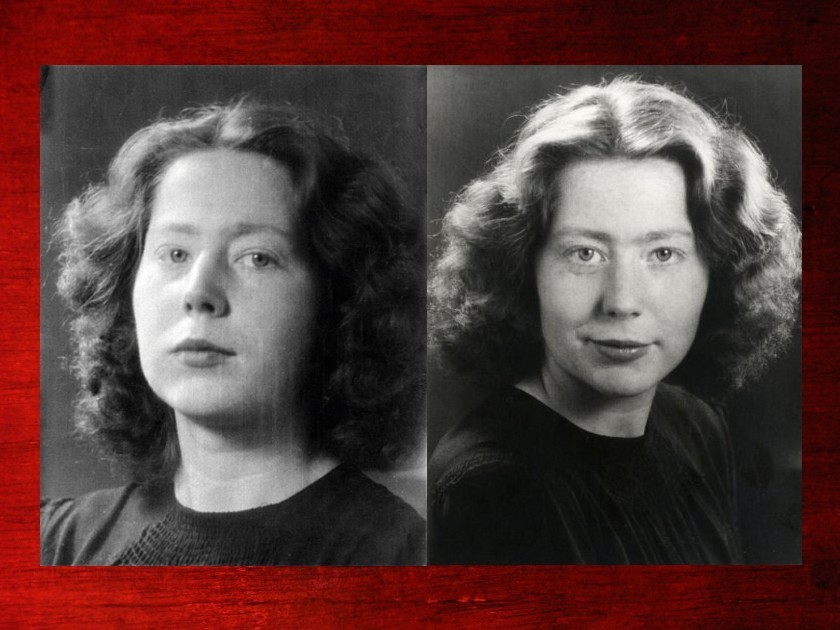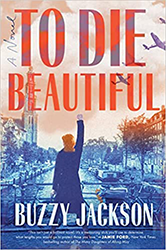
Hannie Schaft, Photographers Unknown, Both photos most likely taken during her time as a student in Amsterdam, between 1938 and 1943
In the winter of 2016 to 2017, my friend and I were at the Verzetsmuseum (Museum of the Resistance) in Amsterdam. It was here I learned the story of Hannie Schaft, a young woman who quit college to fight fascism and became the Nazi’s Most Wanted Woman in the Netherlands during World War II.
My friend suggested I write a book about Hannie’s story. As I stood in front of a small glass display case I saw a pair of round, wire-rimmed glasses, a battered pistol, and a photograph of a young woman with a defiant look on her face. This was the Most Wanted Woman in the Netherlands in the 1940s. This was Jannetje “Hannie” Schaft.
Hannie joined the Dutch Resistance, leaving behind a quiet life of studying law. She learned to use a gun and became a feared assassin, luring Nazi officers and collaborators into alleys with a wink and a smile, only to shoot them point blank in the darkness. She left no trace of herself behind on these assignments. She was not Jewish, but she risked her life to defend and protect Dutch Jews, two in particular – her best friends Philine Polak and Sonja Frenk. I found her story so inspiring.
I wanted to read Hannie’s biography but was astounded to discover that no such book in English existed. Even in Dutch, there were almost no books about Hannie Schaft published in the twenty-first century. My friend was right: I had to write the book myself.
As a historian, there is nothing more thrilling than discovering an overlooked hero. I believe Hannie Schaft is one of the great overlooked heroes of the twentieth century. I assumed I would be writing a straightforward biography of Hannie. But as I got deeper into the material, I discovered the limitations of this approach. Although many aspects of Hannie’s life are well documented through the memories of her friends, some personal correspondence, and the records kept by the German occupiers, there is one significant gap: the voice of Hannie Schaft herself. Resistance fighters knew better than to leave written evidence of their deeds and Hannie was no exception; she gave no interviews and never publicized her actions, since protecting her identity was crucial to her safety during the war. If she kept a diary, it was never found. Without Hannie’s voice in the story, I felt the emotional depth of her experience would be lost. I wanted her story to feel as alive and passionate as her actions show her to be. I began to consider telling her life story in the form of a novel.
Hannie joined the Dutch Resistance, leaving behind a quiet life of studying law.
It was a decision I came to slowly. The historian in me worried about telling the stories of real people, some of whom were still living at the time I began my research. In the summer of 2017 I had the opportunity to meet with the daughter of Truus Oversteegen, Hannie’s colleague in the Resistance and an incredible hero in her own right. With some trepidation, I asked if she would be comfortable with me writing a fictionalized version of her mother’s story. “I think you’d have to,” she said with a smile. “I doubt anyone would want to read it, otherwise.”
This response was crucial to my decision to go forward.
I was curious how other authors approached the issue and quickly realized the most obvious example was sitting on my bookshelf: Thomas Kenneally’s Schindler’s List. Many readers assume the book is nonfiction, but, in Kenneally’s words, it is a “documentary novel,” a tale of fiction based on thorough research and as many supporting documents as the author could find. It’s an approach to history we take for granted in other media such as feature films about historical subjects. When we watch Steven Spielberg’s Lincoln, for example, we know that the essential story is true even though not every line of dialogue can be footnoted. That reassured me. Before finishing the work, Kenneally himself, who was not Jewish, freely admitted that he “doubted” he could write the book. I am Jewish, and the story of the Dutch Holocaust resonated with my own family’s stories of escaping Russian pogroms in the early twentieth century. Like Kenneally, I still had doubts, but I resolved to try. It felt urgent to me that Hannie’s story not be forgotten.
I went on to make contact with more descendants of Resistance fighters, all of whom were gracious and generous with their time, sharing memories and family photographs with me. I was also able to watch recorded video interviews with some of the survivors, now held in the US Holocaust Memorial Museum, which helped me to understand their experiences. I used some of their recorded statements verbatim in the book, as a way to include their voices.
I never expected to write a novel. My goal was to produce a portrait of Hannie Schaft that reflected the woman as her family, friends, and countrymen remember her: a brave, flawed, remarkable hero whose story has as much resonance today as it ever did. I have been humbled by the descendants’ enthusiastic approval of the finished novel, To Die Beautiful. All writers have doubts about their own abilities and I did, too, but ultimately I felt it would be wrong to allow that ever-present voice of criticism stop me from sharing Hannie Schaft’s incredible story with the world.

Read more on Buzzy Jackson’s To Die Beautiful today!
Buzzy Jackson is the award-winning author of three books of nonfiction and has a PhD in History from UC Berkeley. A recent fellow at the Edith Wharton Writing Residency, she is also a member of the National Book Critics’ Circle and writes for The Boston Globe and Bookorum.